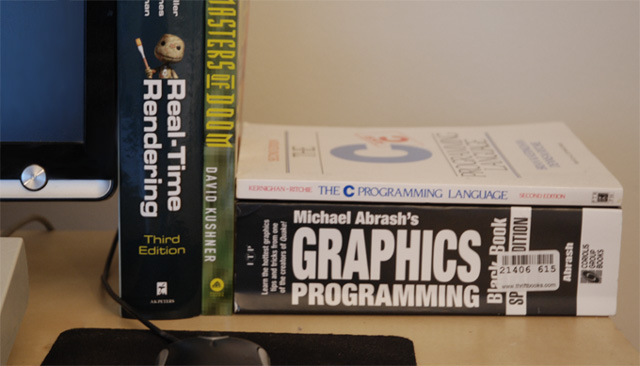Quake Engine code review : Architecture (1/4)
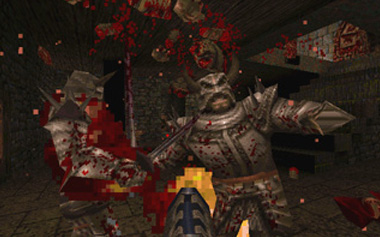 I happily dove into Quake World source code. Here is what I understood, hopefully it will help someone to swim.
I happily dove into Quake World source code. Here is what I understood, hopefully it will help someone to swim.
This article is in four parts :
Architecture section
Network section
Prediction section
Rendition section
Quake Client
A good starting point to study Quake is the qwcl (client) project. The entry point WinMain can be found in sys_win.c. A quick summary of the code is as follows:
WinMain
{
while (1)
{
newtime = Sys_DoubleTime ();
time = newtime - oldtime;
Host_Frame (time)
{
setjmp
Sys_SendKeyEvents
IN_Commands
Cbuf_Execute
/* Network */
CL_ReadPackets
CL_SendCmd
/* Prediction//Collision */
CL_SetUpPlayerPrediction(false)
CL_PredictMove
CL_SetUpPlayerPrediction(true)
CL_EmitEntities
/* Rendition */
SCR_UpdateScreen
}
oldtime = newtime;
}
}
From here, we can identify the three key elements of Quake World:
- Network
CL_ReadPacketsandCL_SendCmd - Prediction
CL_SetUpPlayerPrediction,CL_PredictMoveandCL_EmitEntities - Rendition
SCR_UpdateScreen
The network layer (also called Net Channel) outputs world information into the frames variable ( An array of frame_t). They are picked up by the prediction layer, where collisions are also taken care of and data are outputted under the form of Visibility Edicts (cl_visedicts) and the POV definition. VisEdicts are used by the rendition layer, in addition to the POV (cl.sim*) variables to render the scene.
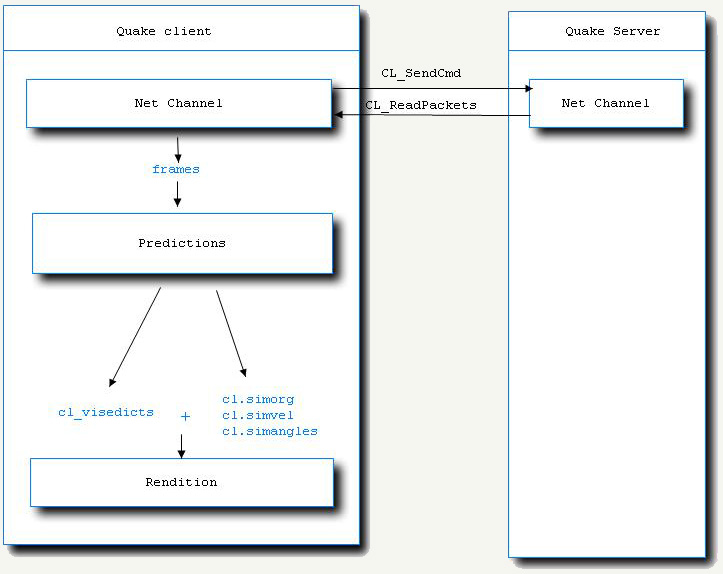
setjmp :
Setup a code waypoint, if anything bad happens, program jumps back here.
Sys_SendKeyEvents :
Retrieve Windows OS messages, minimizing etc... Update engine variable accordingly (world is not rendered if window is minimized for example).
IN_Commands :
Get joystick inputs.
Cbuf_Execute :
In every game loop, commands in the buffer are executed. Commands are generated mostly via the console, but can also come from the server or even direct keystroke.
The game starts with a exec quake.rc in the command buffer.
CL_ReadPackets and CL_SendCmd :
Take care of the Network piece of the engine.
CL_SendCmd grabs the mouse/keyboard inputs, generates a command, which is then sent.
As Quake World used UDP, the reliability is mainly replicated via a set of sequence/sequenceACK in the netChannel packet headers. Additionally, the last sent command is systematically re-sent.
Regarding the flow control, there is no limitation on client side, updates are sent as fast as possible. On server side, a message is sent to a client only if a packet has been received and if the sending rate is below a "choke" limit. This limit is set from client side and sent to the server.
An entire section is dedicated to this part.
CL_SetUpPlayerPrediction , CL_PredictMove and CL_EmitEntities :
Take care of the Prediction piece of the engine as well as collisions. The goal is mainly to fight network communication latency.
An entire section is dedicated to this part.
SCR_UpdateScreen :
Take care of the Rendition piece of the engine. In this part, the BSP/PVS is extensively used. This is also where a fork occurs in the code based on include/define. Quake engine can render the world either with pure software or hardware accelerated.
An entire section is dedicated to this part.
Opening the zip and compiling
Opening the zip:
Upon opening q1sources.zip, there is two folders/Visual Studio projects: QW and WinQuake.
WinQuakeis the code with client and server code melted together, running within one single process (Ideally, they would have been two different processes if DOS had supported them). Network gaming was still possible via LAN only.QWis "Quake World" project, where Server and Client are meant to run on different machine (notice the client staring point isWinMain(insys_win.c), whereas the Server stating point ismain(also insys_win.c)).
I studied Quake World, openGL rendered ; Upon opening the solution, 4 sub-projects can be seen:
gas2asm- Utility to port assembler code from GNU ASM to x86 ASMqwcl- The client part of QuakeQWFwd- Proxy sitting in front of Quake Serversqwsv- The server part of Quake
Compiling:
After installation of Windows and DirectX SDKs, compilation with Visual Studio 2008 raised one error :
.\net_wins.c(178) : error C2072: '_errno' : initialization of a function
Nowadays, _errno is a Microsoft macro used for something else. You can fix these errors by changing the name of the variable from _errno to qerrno for example.
net_wins.c
if (ret == -1)
{
int qerrno = WSAGetLastError();
if (qerrno == WSAEWOULDBLOCK)
return false;
if (qerrno == WSAEMSGSIZE) {
Con_Printf ("Warning: Oversize packet from %s\n",
NET_AdrToString (net_from));
return false;
}
Sys_Error ("NET_GetPacket: %s", strerror(qerrno));
}
The linker will complain about LIBC.lib in qwcl project, just add it to the list of "Ignored Library", the 4 projects should build.
Tools
For the IDE, Visual Studio Express (free), was awesome.
A few books I highly recommend to read if you want to dig further into BSP/PVS based engine, Id Software and Quake:

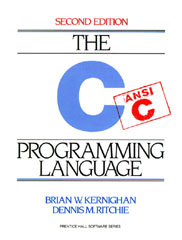
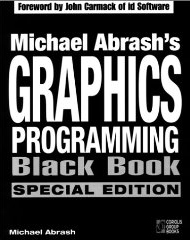
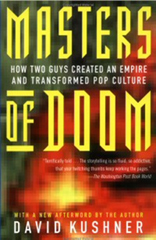
My bookshelf during the Quake Source Code week:
